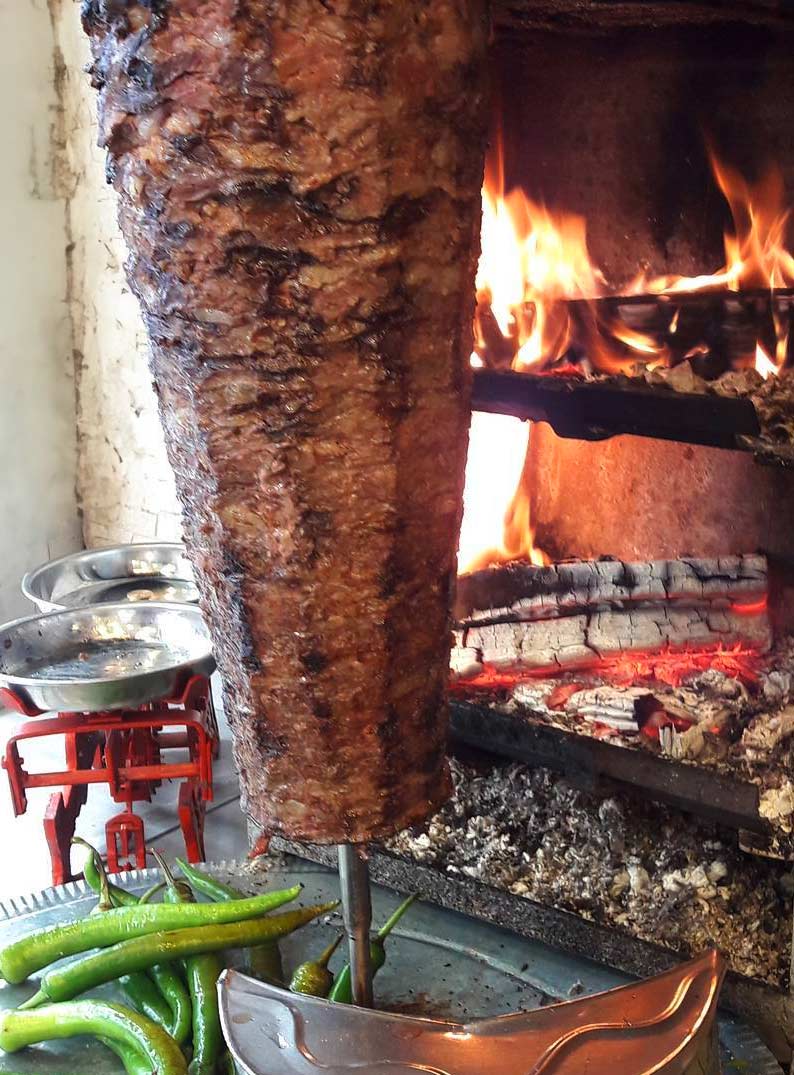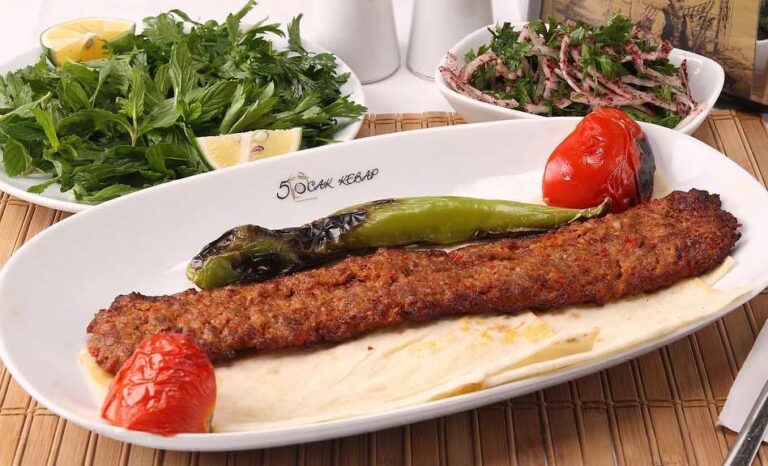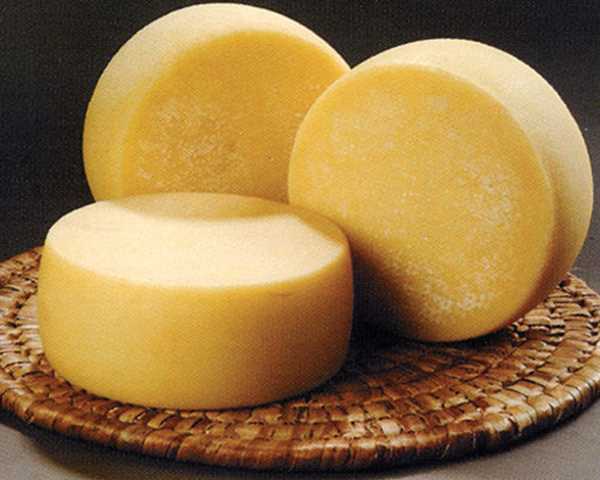The döner kebab, a dish of Turkish origin cooked on a vertical rotisserie, symbolizes a remarkable culinary journey from the Ottoman Empire to a global phenomenon. This article delves into the history, variations, and modern interpretation of the döner kebab, highlighting its significance as a cultural and gastronomic icon.
Origin in the Ottoman Empire
The döner kebab’s story begins in the Ottoman Empire, where meat, traditionally lamb, beef, chicken, or even pork, is cooked on a vertical rotisserie. The concept of cooking meat on a rotisserie is not new, with historical methods involving horizontal cooking similar to the cağ kebab. However, the vertical rotisserie, crucial to döner kebab’s unique preparation, emerged no later than the mid-19th century.
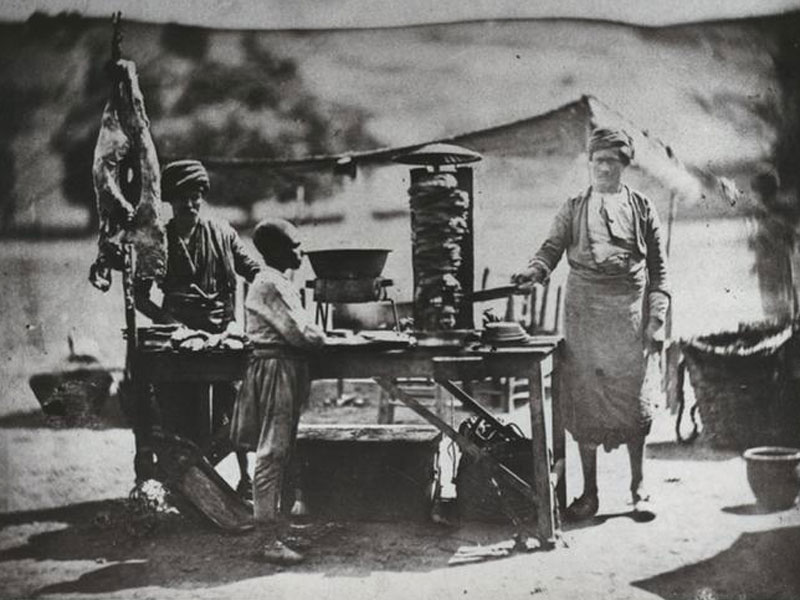
The Birthplace of Döner: Bursa
Bursa, a city in modern-day Turkey, is often credited as the birthplace of the vertically roasted döner kebab. The innovation of roasting lamb vertically instead of horizontally is attributed to İskender Efendi in the 1850s. This culinary invention marked a significant departure from traditional methods and laid the foundation for what would become a worldwide sensation.
Shawarma, Gyros, and Beyond: Global Variations
The döner kebab’s influence spread beyond Turkey, inspiring similar dishes in various cultures. The Arab world adapted it as shawarma, while Greece developed gyros. Both variations are reminiscent of döner but incorporate local flavors and ingredients. Interestingly, the concept also reached as far as Mexico, evolving into the well-known al pastor.
The Berlin Innovation: Döner Sandwich
The transformation of döner kebab into a sandwich variant is a crucial development in its history. In the 1970s, West Berlin saw the emergence of the döner kebab sandwich, popularized by Turkish immigrants. This variant included salads and sauces, encapsulating the essence of fast food convenience. This innovation led to the creation of the dürüm, a wrap using flatbreads like lavash or filo.
Döner Kebab in the Modern Era
Over the years, döner kebab evolved from a dish served on plates to a fast food icon wrapped in bread. Introduced globally by Turkish immigrants, the döner sandwich or wrap became synonymous with convenience and flavor. From Istanbul to London and from New York City to Halifax, the döner kebab, in its various forms, became a staple of fast food cuisine.
From its humble beginnings in the Ottoman Empire to its status as a global street food favorite, the döner kebab stands as a testament to cultural exchange and culinary innovation. Its journey across continents and adaptation into various local cuisines underscores not just the versatility of the dish but also the shared human love for hearty, flavorful food. The döner kebab is not just a meal; it’s a piece of history, continuously evolving and spreading joy with each bite.
The Evolution and Varieties of Döner Kebab: A Turkish Delicacy
Döner kebab, an exquisite dish originating from Turkey, has traversed borders and languages, adapting to various cultures while maintaining its essence. This article explores the linguistic journey of ‘döner kebab’ and the myriad ways it is served in Turkey, its country of origin.
Linguistic Journey of ‘Döner’
The term ‘döner’ is derived from the Turkish word ‘dönmek,’ meaning ‘to turn’ or ‘to rotate,’ aptly describing the cooking method of the dish. In the English language, ‘döner kebab’ is often anglicized as ‘doner kebab,’ substituting the Turkish ‘ö’ with ‘o.’ However, ‘döner kebab’ remains a widely accepted spelling variant in English. The word ‘kebab’ has its roots in Arabic (كَبَاب), permeating through Urdu, Persian, and Turkish languages.
Döner Across Cultures
The concept of döner has been embraced and adapted globally:
- In German, it is spelled ‘Döner Kebab,’ often colloquially referred to as ‘ein Döner.’
- In British English, a döner kebab sandwich is commonly called just ‘a kebab.’
- The Canadian version is known as ‘donair.’
- In Greek, initially called ‘döner,’ it was later renamed ‘gyros,’ derived from γύρος (‘turn’).
- The Arabic equivalent, شاورما (shāwarmā), is inspired by another Turkish word ‘çevirme,’ meaning ‘turning.’
- In Persian, it is referred to as ‘kebab torki.’
Varieties of Döner in Turkey
Turkey, the birthplace of döner, offers an array of variations:
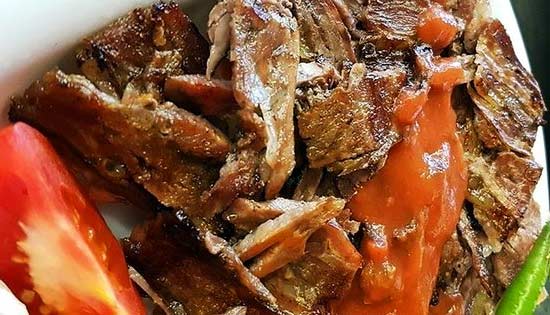
- Porsiyon: Served on a slightly heated plate, sometimes accompanied by grilled peppers or broiled tomatoes.
- Pilavüstü: Döner served over a base of pilaf rice.
- İskender: A specialty of Bursa, named after İskender Efendi. It’s served on an oblong plate atop a base of pide (a flatbread similar to pita), with pepper or tomato sauce and melted butter. The name “Kebapçı İskender” is trademarked by Yavuz İskenderoğlu’s family in Bursa.
- Dürüm: Wrapped in a thin lavaş (flatbread), with two main variants in mainland Turkey:
- Soslu dürüm or SSK (sauce, onion, cheese): Originating from Ankara, it includes İskender kebap sauce.
- Kaşarlı dürüm döner: A specialty of Istanbul, featuring grated kaşar cheese inside the wrap.
- Tombik or Gobit: Döner served in a bun-shaped pita with a crispy crust, softer inside, and generally less meat compared to a dürüm.
- Ekmekarası: A filling version consisting of a whole or half regular Turkish bread filled with döner.
Döner kebab, a culinary gem from Turkey, exemplifies how a simple cooking method can evolve into a globally cherished dish. Its linguistic adaptation and the variety of serving styles in Turkey reflect its cultural significance and adaptability. Whether it’s an İskender in Bursa, a dürüm in Istanbul, or a simple ‘kebab’ in London, the essence of döner continues to tantalize taste buds across the world.
Global Adaptations of Döner Kebab: A Journey Through Continents
Döner kebab, a dish deeply rooted in Turkish culture, has traversed the globe, adapting to regional tastes and ingredients. This exploration highlights its remarkable adaptability and popularity across different continents.
Caucasus, Middle East, and Asia
Azerbaijan
In Azerbaijan, döner kebab is one of the most widespread fast foods, typically wrapped in lavaş or çörәk bread. Primarily made with lamb or mutton, chicken is also a popular option.
Japan
Tokyo, Japan, has embraced döner kebabs, predominantly made of chicken, sometimes beef. Topped with lettuce, tomato, and a variety of sauces like Thousand Islands and garlic, the dish is referred to simply as “kebab”.
Vietnam
Döner kebab’s popularity in Vietnam, especially in Hanoi and Ho Chi Minh City, is attributed to Vietnamese who lived in Germany. The Vietnamese version, Bánh mỳ Döner Kebab, uses pork instead of traditional meats and is garnished with sour vegetables and chili sauce.
Europe
Austria
Across Austria, döner kebabs are a common sight in cities, often outselling traditional foods like burgers and sausages.
Finland
In Finland, döner kebabs rose to popularity post-1990s with the influx of Turkish and Near Eastern immigrants, typically seen as fast food served by late-night pizzerias.
France
Introduced by Turkish immigrants, döner kebab gained a following in France, especially among the North African population. It’s typically served with lettuce, tomato, onions, and various sauces, including the popular sauce blanche. In Paris, it’s known as the “Sandwich grec”.
Germany
Döner kebab in Germany is linked to Turkish immigrants in Berlin in the early 1970s. The Berlin-style döner contains abundant salad, vegetables, and sauces, reflecting a unique culinary fusion. With annual sales of €2.5 billion, it’s a significant fast-food item in Germany.
Netherlands
Kapsalon, a Dutch specialty, includes French fries topped with döner or shawarma meat, cheese, and salad, highlighting another regional twist.
United Kingdom
The UK’s version of döner kebab, brought by Turkish immigrants, is particularly popular after a night out and is often served with chips, in naan, or pita bread.
Americas
Canada
In Canada, the ‘donair’ variation, especially popular in Halifax, features spiced ground beef and a sweet sauce, differing from the traditional recipe.
Mexico
Al pastor in Mexico is a unique adaptation of döner kebab through Lebanese shawarma, usually made with pork and local seasonings.
United States
In the U.S., döner kebab is widely known as gyros, reflecting its Greek variation. This dish has gained prominence since the 1960s, with several claims to its introduction.
Oceania
Australia
In Australia, the multicultural influence has led to a competition between the döner kebab, Greek gyros, and Lebanese shawarma. The Halal snack pack, a combination of döner meat, chips, and sauces, is a popular takeaway item in Australian kebab shops.
The journey of döner kebab from a Turkish specialty to a global street food phenomenon demonstrates its versatility and universal appeal. Adapted to suit local tastes and ingredients from Azerbaijan to Australia, the döner kebab not only signifies culinary adaptation but also cultural exchange and integration. Each region brings its unique touch to this dish, making döner kebab a true symbol of global gastronomy.
Navigating the Health Concerns of Döner Kebab
The global popularity of döner kebab brings with it various health concerns related to its preparation, quality, and nutritional content. This exploration aims to address these concerns by highlighting the challenges and regulatory measures in place.
Hygiene and Preparation
One of the primary health concerns with döner kebab is the hygiene involved in the overnight storage and reheating of partially cooked meat. This process, if not managed correctly, can pose risks of bacterial growth and foodborne illnesses.
Quality and Ingredient Concerns
Investigations in some cases have revealed the use of poor-quality ingredients in döner kebab meat, or the presence of meat types different from those advertised. These findings raise questions about the transparency and integrity of some vendors in the industry.
Nutritional Considerations
Döner kebab, like many fast foods, is often high in salt, fat, and calories. This can be a concern for individuals monitoring their dietary intake or those with health conditions requiring a controlled diet.
Food Safety Regulations
To combat these health risks, most developed countries have implemented strict food safety regulations, some with guidelines specific to döner kebab handling and preparation:
- Canada: Following E. coli outbreaks, Canadian regulations now recommend that döner meat be cooked a second time after being sliced from the rotisserie to ensure thorough cooking and eliminate bacteria.
- Germany: Health regulations in Germany mandate that any döner kebab meat placed onto the rotisserie must be sold the same day. Freezing partially cooked meat for later sale is a violation of these health standards.
The handling of döner kebab, from its preparation to its ingredients and nutritional content, is a matter of concern and requires careful attention from both vendors and regulators. While its popularity as a delicious fast food option remains undiminished, ensuring the health and safety of consumers is paramount. Rigorous enforcement of food safety regulations and increased public awareness are key to addressing these concerns, ensuring that the enjoyment of döner kebab does not come at the expense of health.
The Regional Varieties of Turkish Döner: A Culinary Map
Turkey’s diverse döner varieties offer a rich gastronomic variety, each with unique methods and ingredients. This article examines popular types of döner across Turkey and their distinct characteristics.
General Preparation
In Turkey, lamb is commonly used for döner, although beef and chicken are also frequently used.
Ankara Döner
Originating from Ankara’s districts known for sheep breeding like Çubuk, Beypazarı, Kalecik, Polatlı, and Haymana, Ankara Döner is made exclusively from the meat of mature male lambs weighing over 40 kg. It’s prepared without any ground meat or internal fats except tail fat. Cooked slowly over oak charcoal fire, the meat is served in thin slices and has received a geographical indication.
Oltu Cağ Kebabı
A variety of döner, Oltu Cağ Kebabı from Erzurum in Eastern Turkey, is made from lamb or goat meat. It’s known for its unique cooking style and also holds a geographical indication.
Vegetable Bodrum Döner
Hailing from Bodrum in Muğla, this version incorporates various vegetables like tomatoes, peppers, carrots, peas, and potatoes into the döner.
Ulaş Leaf Döner
The Ulaş Leaf Döner from the Ulaş district in Sivas is characterized by its thinly sliced meat and has been granted a geographical indication.
Bursa Döner Kebab
A part of Bursa’s historical and cultural heritage, Bursa Döner Kebab, also known as İskender kebap, is another variety with a geographical indication.
Antakya Döner Kebab
Made in the Antakya district of Hatay, this döner includes pickles, garlic mayonnaise, fried potatoes, and chicken or beef döner. Its distinctive feature is the thinly sliced bread soaked in tomato sauce and grilled.
Ağrı Leaf Döner
Ağrı Leaf Döner, another geographically indicated variety, comes from the Ağrı province.
The array of döner types in Turkey reflects the country’s rich food culture and geographical diversity. Each variety, with its regional flavors and cooking techniques, holds a significant place in Turkey’s gastronomic map. Geographical indications protect and promote these unique flavors, showcasing the richness of Turkish cuisine to the world.
Chemical Properties of Döner Kebab and Food Safety Standards
The chemical properties of döner kebab are critical factors that define food safety and quality standards. Below are some standard chemical limits for döner kebab and explanations of these properties.
Nutritional Breakdown of 100g Meat Döner Kebab
Let’s analyze the nutritional content of a 100g serving of meat döner kebab, based on the provided data. This smaller portion size can help in understanding its impact on a balanced diet.
Nutritional Content for 100g Meat Döner Kebab
- Energy: 159 kcal (665 kJ)
- Fat: 4.27g
- Saturated Fat: 1.575g
- Trans Fat: 0g
- Monounsaturated Fat: 1.706g
- Polyunsaturated Fat: 0.391g
- Carbohydrates: 19.77g
- Sugars: 1.77g
- Dietary Fiber: 1.1g
- Protein: 9.71g
- Sodium: 264mg
- Cholesterol: 13mg
- Potassium: 209mg
Caloric Distribution
- Carbohydrates: 50% of total calories
- Fat: 25% of total calories
- Protein: 25% of total calories
Comparison to Daily Values
- Based on a standard 2,000 calorie diet, this 100g serving of döner kebab accounts for about 8% of the daily caloric intake.
Interpretation
- Protein Content: The döner kebab provides a decent amount of protein, which is crucial for bodily functions like muscle repair and growth.
- Moderate Fat: The fat content, particularly saturated fat, is moderate. It’s important to balance this with other foods throughout the day.
- Carbohydrates and Fiber: The carbohydrates provide energy, while the fiber content aids in digestion. However, the sugar content, though not very high, should be noted.
- Sodium and Cholesterol: The sodium and cholesterol content are relatively low in this serving size, which is beneficial for heart health and blood pressure management.
- Energy Density: With 159 calories for 100g, this döner kebab is a moderately energy-dense food option.
In a 100g serving size, meat döner kebab presents a balanced mix of protein, carbohydrates, and fats, making it a suitable option for a diverse diet. However, its nutritional value should be considered in the context of an individual’s total daily intake, especially for those with specific health goals or dietary restrictions. Moderation is key, and it’s beneficial to complement this with a variety of other nutrient-rich foods.
Chemical Properties and Standards of Döner Kebab
- pH Value (5.2-6.3):
- The pH value indicates the acidity or alkalinity of the food. An ideal pH range for döner is between 5.2 and 6.3, reflecting the microbiological stability and freshness level of the meat.
- Salt Content (% maximum 2.0):
- Salt content affects both the flavor and preservation of the food. A maximum of 2.0% salt content controls excessive use of salt in döner.
- Total Protein Content (% minimum 12):
- The protein content indicates the nutritional value of döner. A minimum of 12% protein suggests sufficient nutritional content.
- Connective Tissue Content (% maximum 15):
- The connective tissue ratio affects the quality and texture of the meat. 15% or less connective tissue indicates high-quality meat.
- Ammonia Content (mg/100g, maximum 30):
- The level of ammonia indicates the degree of meat spoilage. 30 mg/100g or less ammonia signifies the freshness and health suitability of the meat.
- Peroxide Value (maximum mmol O2/kg 1.5):*
- The peroxide value measures the level of oxidation in fat, thus indicating freshness. A peroxide value of 1.5 mmol O2/kg or lower signifies that the fat is in good condition.
- Arsenic Content (mg/kg, maximum 0.1):
- Arsenic is important to control for toxic substances in meat products. 0.1 mg/kg or less arsenic indicates that the food is safe.
- Lead Content (mg/kg, maximum 0.1):
- Lead, being a toxic element, should be present in low levels. 0.1 mg/kg or less lead content indicates the suitability of the food for health.
These chemical properties and limits play a significant role in determining the quality and food safety aspects of döner kebab production. Adherence to these standards is necessary to ensure the freshness, nutritional value, and health compatibility of the product. Regular monitoring and compliance with these standards are crucial for food safety and consumer health.

